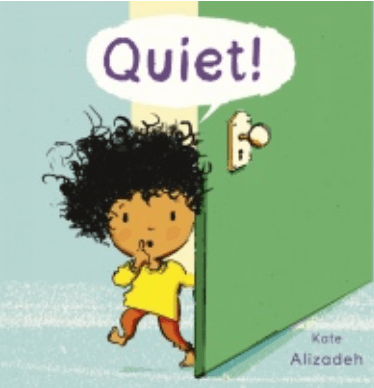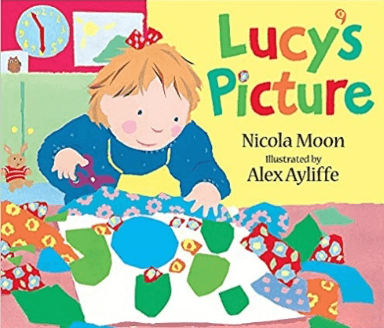Guide 10: Accessible Storytimes
The importance of storytime and libraries
Story and rhyme times are quintessential to the core services provided by public libraries and can oftentimes provide the first experience of babies and toddlers of books and storytelling.
To make sure that this is accessible to children who are blind and partially sighted too, we’ve created this guide for library staff so that their storytimes can be as inclusive as possible.
In order to develop literacy skills, children must first learn concepts, language and ideas, a process called “Emergent Literacy”. Touching and feeling books, listening to reading and storytimes are a major part of this and can be done in a way that is accessible to a child who has sight loss.
Long before children speak, they enjoy listening to the sound of your voice. This also gives them a feel for the sounds, rhythms and rhymes of language. – Booktrust
Which books to pick
When selecting books, select those with clear pictures and good visual contrast. Books should be colourful with simple pictures rather than pictures that are visually cluttered. If the book uses photographs, try to select books with a matted finish instead of glossy to reduce glare. Also, look for books where the print is not written across the pictures, but instead, is placed on a solid background.
If any tactile or braille children’s books are available always use at least one of these in your storytime session. More information at the bottom of the document on how to get these books into your library.
Select reading materials that encourage the reader to make sounds or be extra expressive and that encourage participation (hold objects related to the story, imitate animal sounds in the story, say the repeated parts). Encourage other members of staff and parents to add their sound effects or voices. Talk about new or interesting words in the story, relate the story too familiar experiences or suggest new experiences to try.
Children with sight loss may not be familiar with things that they might otherwise take in from seeing the world around them, so it can be helpful to start with books that contain things that your child has recently experienced. For example, books about going to the park, a trip to the seaside or a visit to the doctor.
Tactual exploration
Educators have long emphasized the importance of tactual exploration i.e. hands-on learning for young children with sight loss. This is important not just for future braille readers who will be using their finely tuned sense of touch to discriminate letters and to decode words, but really for all young children so that they can take in information, build concepts, and further understand their world.
Purposeful exploration involves thinking and concept building. Children gather information through the experiences that they have. This is how they develop an understanding of how things relate. These experiences give meaning to their lives through the development of concepts. Literacy emerges from hands-on experiences for all children
Pairing objects with books and songs
For younger children and those with learning disabilities, provide objects related to the story whenever possible, to actively involve the child and make it a concrete experience. Use or even create book bags or book boxes to accompany stories and books.
It’s become hugely popular to create rhymetime boxes with objects in that children get to pull out of a box to pick the next song, things such as a spider for “incy wincy spider” or a star for “twinkle, twinkle little star”. This is perfect for children with sight loss, as they are able to touch the object, work out what it is and then relate it to the song.
Using other senses
If you are able, try to use smell as well as touch and sound when holding a storytime session. This is often more challenging, but if you are able to hold a storytime session outside in a garden area, having grass, flowers and leaves available for children to smell and touch, where they are mentioned in a story such as Little Red Riding Hood or The Very Hungry Caterpillar, adds a tremendous amount of enrichment.
Representation
While finding a book that represents someone living with sight loss is unfortunately not an easy task but below two children’s books where one of the characters is either blind or has sight loss.

Ssh! Listen. What’s that noise? What can we hear when we’re really, really quiet? A toddler enjoys the range of sounds they hear as their busy day comes to an end, from the bustle and chat of dinner time to the quiet hush of their father’s voice at bedtime. The text and sensory clues to be found in this enchanting, inclusive picture book allow us to experience our home through its many noises. Auditory landmarks help all children to become familiar with daily routines and can be particularly important to those who are blind or partially sighted.

Lucy wants to make a picture for her grandpa, but she doesn’t want to use the brightly coloured paints with the rest of the children. Lucy’s grandpa is blind, so Lucy makes him a very special picture with twigs, feather, velvet and sand – a picture he can feel with his fingers. This heart-warming story about a little girl’s imagination and the love between grandchild and grandparent is perfect for sharing with young children
Of course, representation is important in all aspects, not just disabilities and always vital to consider when planning your storytime sessions.
Getting braille, tactile and large print books into your library
ClearVision is a postal lending library of children’s books designed to be shared by visually impaired and sighted children and adults. They lend books all across the UK and Ireland.
Their books all have braille, print and pictures. This allows children with little or no sight to share books with their sighted friends and family, and adult braille readers to enjoy stories with sighted children. There are over 14,000 books in the collection, catering for children from birth until they’re independent readers.
Anybody in the UK or Ireland who needs children’s books with both braille and print text is welcome to join the ClearVision library. The books are sent directly to your address and there is no postage to pay. Membership is free to families; organisations such as schools, libraries and sensory support services pay a heavily subsidised annual fee of £50.
Contact them on 020 8789 9575 or [email protected].
Guide Dogs don’t believe a vision impairment should stop you, or any children, from knowing the joy of reading. That’s why CustomEyes Books in large print give them the chance to read a real book, just like everybody else.
From Dr Seuss to Shakespeare, from inspirational fiction to educational textbooks, they have over 4,200 large print books available – and counting. Each one is custom made, with font size, spacing, colour and more all tailored to the child’s individual needs.
CustomEyes Books for a child with sight loss means children and young people can have exactly the same books as their friends and classmates. This not only helps them keep up at school, they can share books with friends too.
If the child is not comfortable using a magnifier, or gets tired using a screen, they can pick up a real book and still enjoy reading and learning.
Becoming a CustomEyes Books member is easy and completely free. And thanks to a generous Guide Dogs subsidy, all large print books are available at the recommended retail price, regardless of format.
Contact them on 0118 983 8275 or [email protected].
Guide for creating a book bag or book box
- Select a story. A bright, high-contrast picture or story book that you think would appeal to the age range and you can find objects easily for. Some examples are: Little Red Riding Hood, Goldilocks and the Three Bears, The Very Hungry Caterpillar, Hansa’s Surprise.
- Box or bag? Shoe box or storage box? Choose the most appropriate container for your story book and objects, so that it’s easy to store, find and you don’t mind the children rummaging through it.
- Which items? You want at least one item per page or significant event of the story.
- Label the exterior of the container. A tactile marker will enable you and your child to “read” the title; e.g., three pieces of fake fur might be a good label for the story of Goldilocks and the Three Bears.
- Prying these boxes open is a beneficial activity which develops the hand dexterity needed to use braille, so it would be good to let the children handle the box or bag.
- Reading the story – have fun! Get everything out, touch and talk about everything.
- When you are finished with the story box put clear closure on the activity by having the children help place the objects back in the box, thus providing another opportunity to handle the objects.